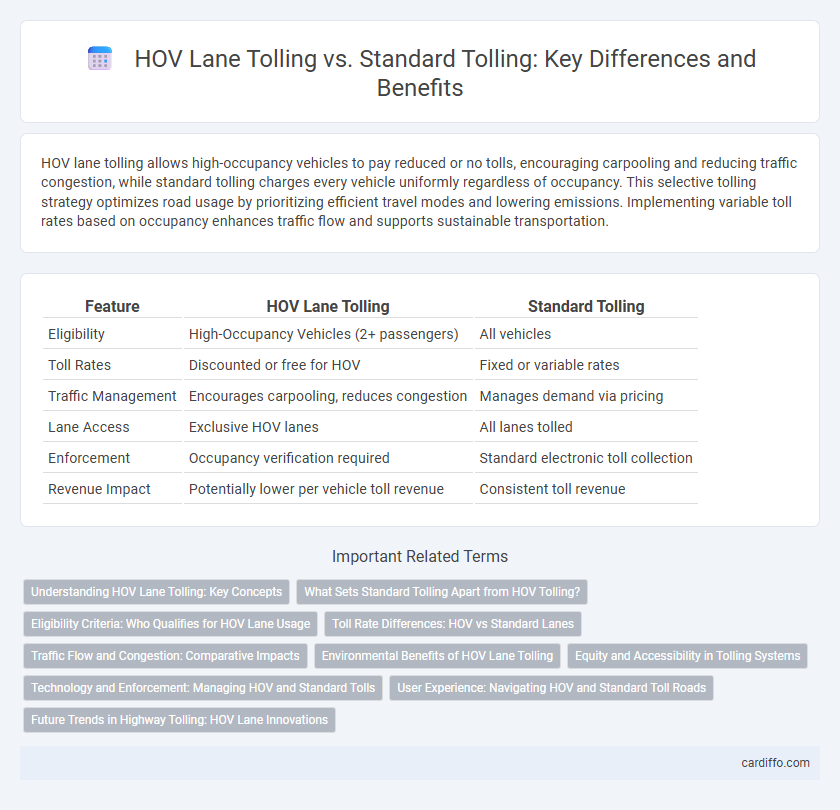HOV lane tolling allows high-occupancy vehicles to pay reduced or no tolls, encouraging carpooling and reducing traffic congestion, while standard tolling charges every vehicle uniformly regardless of occupancy. This selective tolling strategy optimizes road usage by prioritizing efficient travel modes and lowering emissions. Implementing variable toll rates based on occupancy enhances traffic flow and supports sustainable transportation.
Table of Comparison
| Feature | HOV Lane Tolling | Standard Tolling |
|---|---|---|
| Eligibility | High-Occupancy Vehicles (2+ passengers) | All vehicles |
| Toll Rates | Discounted or free for HOV | Fixed or variable rates |
| Traffic Management | Encourages carpooling, reduces congestion | Manages demand via pricing |
| Lane Access | Exclusive HOV lanes | All lanes tolled |
| Enforcement | Occupancy verification required | Standard electronic toll collection |
| Revenue Impact | Potentially lower per vehicle toll revenue | Consistent toll revenue |
Understanding HOV Lane Tolling: Key Concepts
HOV lane tolling typically charges solo drivers a variable fee to use high-occupancy vehicle lanes, encouraging carpooling and reducing congestion. Unlike standard tolling, which applies fixed fees based on vehicle type or distance, HOV tolling adjusts rates dynamically based on real-time traffic conditions. Key concepts include occupancy verification methods, dynamic pricing models, and exemptions for qualifying carpools or clean vehicles.
What Sets Standard Tolling Apart from HOV Tolling?
Standard tolling charges all vehicles a fixed fee regardless of occupancy, promoting uniform revenue collection and ease of implementation. HOV lane tolling differentiates fees based on vehicle occupancy, offering discounted or waived tolls to encourage carpooling and reduce congestion. This occupancy-based pricing in HOV tolling targets traffic management goals beyond revenue, unlike the uniform approach of standard tolling.
Eligibility Criteria: Who Qualifies for HOV Lane Usage
HOV lane tolling typically requires vehicles to have two or more occupants or be registered as carpools to qualify for reduced or no toll fees, differentiating it from standard tolling where all vehicles pay a flat rate regardless of occupancy. Eligibility criteria for HOV lanes often include verification of vehicle occupancy through electronic toll collection systems, carpool stickers, or occupancy sensors. Some regions extend exemptions or discounted rates to electric or hybrid vehicles in HOV lanes, further distinguishing access policies from standard tolling practices.
Toll Rate Differences: HOV vs Standard Lanes
HOV lane tolling typically offers lower rates compared to standard lanes to incentivize carpooling and reduce traffic congestion. Standard tolls are generally higher as they charge all vehicles regardless of occupancy, reflecting the greater demand on road infrastructure. These toll rate differences are calibrated to balance traffic flow and encourage environmentally friendly commuting options.
Traffic Flow and Congestion: Comparative Impacts
HOV lane tolling improves traffic flow by incentivizing carpooling, which reduces the number of vehicles and alleviates congestion in high-occupancy vehicle lanes. Standard tolling applies a uniform charge to all vehicles, often leading to slower traffic movement and increased bottlenecks during peak hours. Comparative studies show HOV lane tolling can enhance lane efficiency and reduce overall travel time more effectively than traditional tolling methods.
Environmental Benefits of HOV Lane Tolling
HOV lane tolling significantly reduces vehicle emissions by encouraging carpooling and decreasing single-occupancy vehicle use, leading to lower congestion and improved air quality. Studies show that HOV toll lanes can cut greenhouse gas emissions by up to 30% compared to standard tolling on multi-occupancy routes. This environmental benefit supports sustainable transportation goals and contributes to urban areas meeting clean air standards more effectively.
Equity and Accessibility in Tolling Systems
HOV lane tolling enhances equity by allowing vehicles with multiple occupants to access reduced or no toll rates, promoting carpooling and reducing traffic congestion. Standard tolling methods often impose uniform fees, which can disproportionately burden low-income drivers who cannot afford peak pricing or alternative transportation. Implementing flexible tolling structures that consider vehicle occupancy and income levels improves accessibility and fairness in transportation funding.
Technology and Enforcement: Managing HOV and Standard Tolls
HOV lane tolling utilizes advanced electronic toll collection systems, including RFID and automated license plate recognition, to differentiate vehicles based on occupancy and enforce payment compliance effectively. This technology allows real-time monitoring and dynamic pricing adjustments, optimizing traffic flow and ensuring only eligible vehicles access discounted or free HOV rates. Enforcement relies on integrated camera systems and data analytics to identify violators, streamlining penalties and maintaining lane integrity without disrupting travel.
User Experience: Navigating HOV and Standard Toll Roads
Navigating HOV lane tolling offers a smoother user experience with reduced congestion and faster travel times compared to standard toll roads, where traffic and toll booth delays are more common. Electronic toll collection systems, such as RFID transponders or license plate recognition, streamline payments for both HOV and standard lanes, but HOV lanes often feature lower toll rates or exemptions for eligible vehicles. User satisfaction improves in HOV lanes due to dedicated infrastructure, priority signaling, and less stop-and-go traffic, contrasting with the variable toll pricing and heavier traffic in standard toll lanes.
Future Trends in Highway Tolling: HOV Lane Innovations
Future trends in highway tolling emphasize HOV lane innovations such as dynamic pricing models that adjust toll rates based on real-time traffic conditions to optimize lane utilization and reduce congestion. Integration of advanced vehicle-to-infrastructure (V2I) technology enables seamless payment processing and enforcement, enhancing the efficiency of HOV lane tolling systems. Predictive analytics and AI-driven demand management are increasingly employed to balance traffic flow while promoting carpooling and environmental sustainability.
HOV lane tolling vs standard tolling Infographic

 cardiffo.com
cardiffo.com